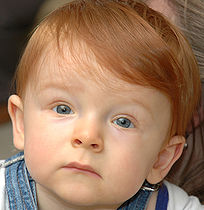Stuttering in children or stammering is a common speech disorder in children. When a child stutters, he/she may prolong or repeat a word, a phrase or a syllable, he/she may suddenly stop in speech or conversation or he/she may make no sounds for some syllables. The children who stutter have knowledge of the facts which they want to talk about, but have problems in saying them.
Stuttering may cause a lot of discomfort and distress in children as they are unable to communicate properly and are sometimes subjected to ridicule and embarrassment by their peers.
Stuttering in children usually goes away on its own as the children grow up and increase their vocabulary.

Symptoms of stuttering in children
Some of the symptoms of stuttering in children are as follows:
• A phrase, word or syllable may be prolonged or there may be repetition
• Children may face difficulties or problems in commencing a sentence, a word or a phrase
• The problems in speech may come in conjunction with physical symptoms such as rapid blinking of the eyes, tremors or trembling of the jaw or lips and tightness or tension in the facial muscles or the upper body.
• Children who stutter may face increased instances of stuttering when they are stressed, excited or tired, when they feel pressured, hurried or self conscious and/or in situations such as public speaking or talking in the telephone or mobiles.
Causes of stuttering in children
Some of the causes and risk factors of stuttering in children are listed below:
• When there is delay in the development of language or speech abilities in children, it may result in stuttering in children.
• There may be some abnormalities in that part of the brain which controls speech and language. These abnormalities may be passed on to the children by their parents. Thus genetic abnormalities may also result in stuttering in children.
• Any injury or trauma to the brain or a stroke may result in stuttering and other speech impediments.
• Psychological and mental disorders like emotional trauma, may affect the cognitive and reasoning capabilities in children which may result in stuttering.
• Male children are at greater risk to develop stuttering than females.
Treatment of stuttering in children
Stuttering in children usually goes away with time as they grow up. However, if stuttering in the child continues for over a period of time along with an increase in frequency, then it may result in emotional and psychological problems as well as avoidance of social interactions and schoolwork. In such scenarios, parents need to treat the causes and symptoms of stuttering in their child.
• There are no medications available for the treatment of stuttering in children.
• There are a number of ways to correct the speech deficiency in children. Controlled fluency is a method that teaches the children to deliberately slow the rate of speech and recognize the patterns of stuttering, resulting in better speech structure and removal of stutters.
• Some types of specific electronic devices also help in correcting stuttering in children.
• Parental guidance and appreciation goes a long way in correcting stuttering in children.
• Cognitive behavioral therapy and counselling may assist a child in cognitive reassessment of situations and thoughts, thereby leading to corrections in stuttering in children.
• Parents may also contact any of the organizations mentioned below for further support to correct stuttering in children.
o NIDCD Information Clearinghouse at nidcdinfo@nidcd.nih.gov
o National Stuttering Association at http://www.nsastutter.org/
o Stuttering Foundation of America at http://www.stutteringhelp.org/